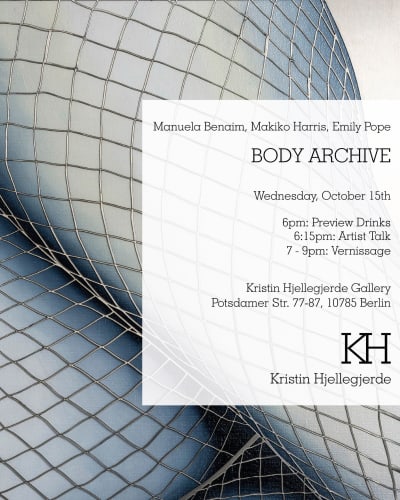Artist Talk + Private View: Body Archive in conversation with Kimberly Bradley: Berlin, Germany
Body Archive
6:00pm drinks
6:15pm The artists in conversation with Kimberly Bradley
7-9pm Vernissage
Kristin Hjellegjerde Gallery
Mercator Hoefe
Potsdamer Str. 77-87
10785 Berlin, Germany
Emily Pope, Makiko Harris and Manuela Benaim
Fragmented body parts, twisting torsos, masked and floating faces. Body Archive brings together three artists whose practices variously explore the female body as site, surface and symbol. Drawing on art history, mythology, and contemporary representations of femininity, the works in this exhibition examine the complexities of selfhood, desire, memory and the performance of identity.
Emily Pope’s tightly cropped paintings place us in the unsettling role of the voyeur, as if we are peering through a letterbox or observing a peep show, catching glimpses of a body that feels both familiar and strange. This is especially true in the work depicting a voluptuous, milky torso and exposed breasts. The body here is an archetype, derived from a compilation of art historical references and the artist's personal archives - a form we feel we’ve encountered before, but can’t quite place. Similarly, paintings of a woman’s raised collarbones and tightly corseted body evoke a haunting sense of recognition, even as the context for these figures is deliberately stripped away, leaving us to fill in the gaps. These works invite us in, only to hold us at arm’s length, challenging us to reflect not only on the long history of women’s objectification, but also on how cultural symbols endure, even as their meanings unravel.
The question arises: is the body performing for us, or is it our perspective that shapes the image? Or perhaps it is a combination of both. Pope’s paintings ask us to confront the difficulty of transcending inherited ideas of the female form, while also questioning how these symbols continue to shape our understanding of identity.
Makiko Harris’s work also grapples with the cultural and social expectations placed on the female body. New works from her ongoing Stocking Series envision ambiguous fleshy body parts bulging against what first appears to be fishnet tights, but closer inspection reveals a rigid layer of galvanised steel. What might initially be read as a fetishised or vulnerable body becomes, instead, a deliberate manipulation of visibility and concealment. The steel netting replaces the softness of traditional lingerie, transforming the act of revealing into an assertion of control, autonomy and resistance. In this shift, Harris critiques the longstanding commodification of the female form, asserting that what is visible is not always a passive invitation, but an active negotiation of how the body is framed and understood.
For the first time, Harris also extends this line of research through portraits where the steel netting becomes a mask, simultaneously concealing the figure and hinting at layers of unconscious beneath. Again, the use of steel suggests that visibility — or the withholding of it — can be an act of power. In choosing what to reveal and what to hide, Harris invites us to reflect on the autonomy of self-presentation in a world where the female body remains subject to constant scrutiny.
A collection of sculptures by Manuela Benaim — faces cast in silicone and sealed in resin — also considers the ways in which the body is examined. Frozen in time, these faces become vestiges of discarded selves or portraits of a moment just before transformation. They suggest the possibility of many lives within a single lifetime — identities renewed, expanded and continuously becoming. Benaim’s choice of silicone, which mimics skin, and resin, which both preserves and obscures, reflects the tension between memory and possibility. Here, preservation is not an endpoint, but a pause before the next iteration.
Alongside the faces, Benaim presents a series of framed belly buttons: devotional silicone life casts that capture the body’s intimate terrain. These navels become quiet monuments to origin — markers of connection between self and ancestry, individuality and the shared human condition. Each form, with its freckles, folds and fine hairs, honours both singularity and commonality, holding space for what has been and what might yet emerge.
In this way, Body Archive invites us to consider how our understanding of and relation to the body is not only shaped by history and culture, but how we might also find space for reclamation, resistance and reimagining.
